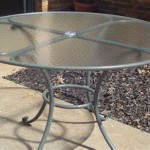Concrete Patio with Flagstone Border: A Comprehensive Guide
The integration of concrete and flagstone in patio design offers a compelling blend of affordability, durability, and aesthetic appeal. A concrete patio with a flagstone border provides a cost-effective base material complemented by the natural beauty and textural richness of flagstone around the perimeter. This combination allows homeowners to create an outdoor living space that is both functional and visually striking without incurring the significantly higher cost of a full flagstone patio.
This article delves into the various aspects of designing, constructing, and maintaining a concrete patio featuring a flagstone border. It will cover considerations for design, materials, installation techniques, and long-term care to ensure a successful and enduring outdoor space.
Design Considerations for a Concrete Patio with Flagstone Border
Planning is essential for any successful outdoor project, and a concrete patio with a flagstone border is no exception. Careful consideration of several factors during the design phase will contribute significantly to the final outcome’s success and longevity.
The first consideration is the overall size and shape of the patio. This should be proportionate to the size of the yard and the intended use of the space. Consider how many people you typically entertain and the type of furniture that will be placed on the patio. The shape should complement the architectural style of the house and the existing landscape. A rectangular or square patio is often the easiest to construct, but curved or free-form shapes can add visual interest. When choosing shapes, keep in mind the additional cuts you will need to make to the flagstone to accommodate curves. A larger number of cuts means greater waste and greater installation difficulty.
The location of the patio is another critical factor. Consider the amount of sunlight the area receives throughout the day. If the location is exposed to intense afternoon sun, you may want to incorporate shade structures, such as pergolas or awnings. Evaluate the drainage patterns of the yard to ensure that the patio will not be subject to standing water. Ensure the patio location does not impede existing drainage patterns.
The choice of flagstone and concrete finishes is crucial for the aesthetic appeal of the patio. Flagstone comes in a variety of colors, textures, and sizes. Select a flagstone that complements the color of the house and the surrounding landscape. Consider the texture of the flagstone; a rough texture will provide better traction, while a smoother texture will be easier to clean. Concrete can be stained, stamped, or textured to create a variety of looks. Staining concrete provides a uniform color throughout. Stamping concrete simulates the look of other materials, such as brick or cobblestone. A simple broom finish provides a non-slip surface and a clean, modern look.
Finally, consider the transition between the concrete and the flagstone. A smooth, even transition will enhance the overall look of the patio, while a rough or uneven transition can be unsightly and even a tripping hazard. Ensure that the flagstone border is level with the concrete surface. A slight slope away from the house is necessary for proper drainage.
Materials and Installation Techniques
The selection of appropriate materials and the utilization of proper installation techniques are paramount to the durability and aesthetic integrity of a concrete patio with a flagstone border. A thorough understanding of these elements is essential for achieving a professional and long-lasting result.
For the concrete base, use a high-quality concrete mix specifically formulated for outdoor use. The mix should have a compressive strength of at least 4000 psi to withstand weathering and heavy use. Reinforcing the concrete with wire mesh or rebar is highly recommended, especially in regions with freeze-thaw cycles. The reinforcement will help prevent cracking and extend the lifespan of the patio.
The choice of flagstone is equally important. Select flagstone that is durable, weather-resistant, and appropriate for outdoor use. Common types of flagstone include sandstone, slate, and limestone. Ensure that the flagstone is of consistent thickness to facilitate a level installation. The size and shape of the flagstone will also affect the overall look of the patio. Larger pieces of flagstone will create a more formal look, while smaller pieces will create a more rustic look.
Proper site preparation is crucial before pouring the concrete. Clear the area of all vegetation, debris, and topsoil. Excavate the area to a depth of at least 6 inches. Install a compacted gravel base to provide drainage and support for the concrete slab. The gravel base should be at least 4 inches thick and compacted in layers. Use a plate compactor to ensure that the gravel base is properly compacted. This compacting is critical to ensure the long-term stability of the patio and prevents sinking or shifting over time.
When pouring the concrete, ensure that it is evenly distributed and properly leveled. Use a screed board to strike off the concrete and create a smooth, level surface. Allow the concrete to cure properly before applying any sealers or finishes. Curing involves keeping the concrete moist for several days to allow it to fully hydrate and gain strength. Cover the concrete with plastic sheeting or spray it with a curing compound to prevent it from drying out too quickly.
Setting the flagstone border requires careful attention to detail. Use a mortar mix specifically formulated for setting stone. Apply the mortar to the back of the flagstone and carefully set it in place. Ensure that the flagstone is level with the concrete surface and that the joints between the flagstone pieces are consistent. Use shims to adjust the level of the flagstone as needed. After the mortar has cured, fill the joints between the flagstone pieces with mortar. Use a grout bag or pointing trowel to apply the mortar. After the mortar has partially cured, use a damp sponge to clean the excess mortar from the surface of the flagstone.
Maintaining Your Concrete Patio with Flagstone Border
Regular maintenance is crucial for preserving the appearance and prolonging the lifespan of a concrete patio with a flagstone border. Implementing a consistent maintenance routine will help prevent damage and keep the patio looking its best for years to come.
One of the most important aspects of maintenance is regular cleaning. Sweep the patio regularly to remove dirt, leaves, and other debris. Use a garden hose or pressure washer to rinse the patio and remove any stubborn stains. Avoid using harsh chemicals or abrasive cleaners, as these can damage the concrete and flagstone. A mild detergent and water solution is usually sufficient for cleaning purposes.
Sealing the concrete and flagstone is also essential for protecting them from the elements. A good sealer will help prevent staining, water damage, and freeze-thaw damage. Apply a concrete sealer to the concrete surface and a stone sealer to the flagstone surface. Follow the manufacturer's instructions for application. Reapply the sealer every one to two years, or as needed, depending on the level of traffic and exposure to the elements.
Inspect the patio regularly for cracks or other damage. Small cracks can be repaired with a concrete patching compound. Larger cracks may require professional repair. Address any cracks promptly to prevent them from worsening. Inspect the mortar joints between the flagstone pieces for any signs of deterioration. Repair or replace any damaged mortar joints to prevent water from seeping underneath the flagstone.
Protect the patio from excessive weight and impact. Avoid placing heavy objects on the patio, and be careful not to drop heavy objects on the surface. Use furniture pads under the legs of chairs and tables to prevent scratching. During the winter months, avoid using de-icing salts on the patio, as these can damage the concrete and flagstone. Use sand or gravel for traction instead.
Finally, consider protecting the patio from the sun. Prolonged exposure to the sun can cause the concrete and flagstone to fade over time. Plant trees or shrubs to provide shade, or use an awning or pergola to create a shaded area. Regularly inspect the patio for any signs of mold or mildew growth. Clean any affected areas with a mold and mildew remover. Ensure that the patio is properly ventilated to prevent mold and mildew from recurring.
By following these maintenance tips, homeowners can ensure that their concrete patio with a flagstone border remains a beautiful and functional outdoor space for many years to come. These simple steps will protect the investment and provide an inviting area for relaxation and entertainment.

Flagstone Patios With Borders Blackwater Concrete

Concrete Patio With Stamped Border Cement Extension Ideas

Flagstone Photos

Stamped Concrete Mimics Flagstone Landscaping Network

Colored Concrete Patio With Circular Fire Pit Traditional Atlanta By Botanica Landscape Design Build Maintain Houzz

Stamped Concrete Patio With Border By Swiss Village Designs Design

Combining Concrete Natural Stone Network

Design Ideas For Stamped Concrete Patio Sundek Houston

Stamped Concrete Mimics Flagstone Landscaping Network

Flagstone Patio I Like How This Is Edged Design Stones








